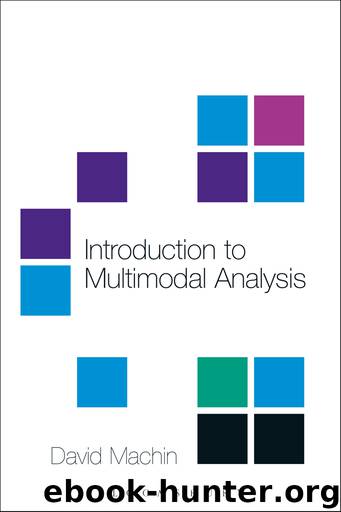Introduction to Multimodal Analysis (A Hodder Arnold Publication) by David Machin

Author:David Machin [Machin, David]
Language: eng
Format: azw3
Publisher: Bloomsbury Publishing
Published: 2016-09-22T04:00:00+00:00
■Line spacing and alignment
Ellen Lupton, in her book Thinking with Type (2004), makes a number of points about the line spacing and alignment of text that we can draw upon to think a little more about the interpersonal function of typography, the mood or attitude it can convey and the ideas it communicates.
Line spacing is simply the distance between the baseline of one line of type and the top of another. This can have the same metaphorical association as expansion above. When the gap is small there can be the impression of claustrophobia, of crowding or also of economy. Wider spaces can mean more expansive, confident or also greedy. But this sense of space can draw heavily on associations of modernism and open spaces. Here there are associations of modernism, the economy of design features and the luxury of space. The space can also metaphorically represent the peace and relaxation, the ease that is a feature of minimalism and large, airy rooms. We can also place other information between these lines.
We can see, then, that this interpersonal level of communication can convey a kind of attitude, a mood. Is the communicator expressing themselves through an arrogant or relaxed mood, for example?
Alignment of typeface is something we are familiar with on our word processors through the term ‘justified’. Yet we may not be familiar with thinking about this in terms of meaning potential. Consider the following examples (inspired from Lupton 2004: 120).
■Even on both sides
In this piece of text the left and right edges are even. Here text is made to appear that it is bordered and controlled. This might be important for a newspaper where it might give a sense of efficiency, authority and formality.
We can see an example of this used for the blocks of news text on the older version of the Liverpool Daily Post. Here it would be used to connote authority and formality.
■Even on the left only
In this piece of text the left edge is even whereas the right is not. This can look slightly more organic. It allows the words to take up the space that they wish. It does not regiment them. It is slightly more natural and relaxed.
We can see that the newer version of the Liverpool Daily Post uses this kind for its blocks of text to move away from the formality and authority. This is important for the relaxed feel of the new brand.
■Even on the right only
In this piece the left is ragged but the right is even. Since in the west we begin reading from the right, this makes it slightly more difficult to follow. Each line takes up a different position. This gives even less formality to the writing therefore. It does not want to be easy to read. It wants you to work at it. We might say that by association this is a confident attitude. Confident in what it has to say. It gives the sense of a commentary that is important. It is also used to provide textual coherence in right-hand marginal notes.
Download
This site does not store any files on its server. We only index and link to content provided by other sites. Please contact the content providers to delete copyright contents if any and email us, we'll remove relevant links or contents immediately.
| Anthropology | Archaeology |
| Philosophy | Politics & Government |
| Social Sciences | Sociology |
| Women's Studies |
Cecilia; Or, Memoirs of an Heiress — Volume 1 by Fanny Burney(32436)
Cecilia; Or, Memoirs of an Heiress — Volume 2 by Fanny Burney(31872)
Cecilia; Or, Memoirs of an Heiress — Volume 3 by Fanny Burney(31857)
The Great Music City by Andrea Baker(31369)
We're Going to Need More Wine by Gabrielle Union(18970)
All the Missing Girls by Megan Miranda(15583)
Pimp by Iceberg Slim(14397)
Bombshells: Glamour Girls of a Lifetime by Sullivan Steve(13977)
Talking to Strangers by Malcolm Gladwell(13225)
Norse Mythology by Gaiman Neil(13210)
Fifty Shades Freed by E L James(13158)
For the Love of Europe by Rick Steves(13035)
Mindhunter: Inside the FBI's Elite Serial Crime Unit by John E. Douglas & Mark Olshaker(9206)
Crazy Rich Asians by Kevin Kwan(9170)
The Lost Art of Listening by Michael P. Nichols(7409)
Enlightenment Now: The Case for Reason, Science, Humanism, and Progress by Steven Pinker(7238)
The Four Agreements by Don Miguel Ruiz(6636)
Bad Blood by John Carreyrou(6553)
Weapons of Math Destruction by Cathy O'Neil(6147)
